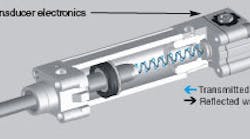Microwave sensor: Innovative measuring principle with transmitter and receiver beams.
Perhaps the greatest need when integrating electronic control into fluid power applications has been a precise, reliable, inexpensive, and easy-to-install linear displacement transducer for installation within cylinders.
For years, magnetostrictive transducers have been the standard for closed-loop control of cylinder position. Magnetostrictive transducers provide extremely precise and repeatable position sensing, high reliability, and long life. However, they are more expensive than other types of in-cylinder transducers. Resistive transducers cost considerably less, but because their sensing elements require physical contact, they have a finite life and physical speed limitation.
Other types of transducer technologies have also been used, but no matter which technology is involved, integral cylinder mounting requires extensive machining to "gun-drill" the cylinder's piston rod. Gun drilling involves boring out the center of the piston rod to accommodate the transducer.
However, Festo Corp., recently introduced an in-cylinder lineardisplacement transducer that does not require gun drilling the piston rod. Instead, it uses a microwave transmitter-receiver antenna that simply mounts in the end cap of a cylinder. It transmits a microwave signal that travels axially toward the cylinder's piston. The microwave signal is reflected off the piston and back toward the antenna. As with magnetostrictive sensors, control electronics differentiate the time between signal generation and reception to calculate position of the piston.
Armin Seitz, head of Festo's Business Unit Sensors, reveals, "This sensor system is the first to offer non-length dependent displacement measurement for pneumatic or hydraulic linear drives. This means there is no need to produce sensors in sizes for individual cylinder strokes. One size fits all, so the sensor can be installed in cylinders of different lengths."
Seitz says the entire transducer is contained within the end face of a cylinder, where it continuously measures piston position and speed
across the entire cylinder stroke range. Continuous detection of status, position, and speed facilitates monitoring of motion sequences and offers precise diagnostics and preventive maintenance.
Mode of operation
As with those used in telecommunications and automobile industries, the transducer uses microwaves ranging in frequency from 1 to 24 GHz. A simple antenna system transmits electromagnetic waves into the cylinder barrel, which acts as a hollow conductor. The waves are reflected by the piston, and the reflected signal is received by the same antenna, compared with the transmitted signal, and evaluated. Measurement length is unlimited and is governed automatically by the stroke of the cylinder. Projects have already been produced with stroke lengths to 1500 mm.
Seitz explains that virtually every displacement transducer used in pneumatics, such as potentiometers or magnetostrictive sensors, can be replaced by microwave sensors. Because of the transducers' high resolution, measurement operations can be carried out using the cylinder itself, eliminating the need for additional external sensors. For example, a product to be processed can be checked for correct position, or the dimensions of workpieces can be measured.
Inherent advantages
Compared to conventional displacement transducers, microwave transducers offer shorter commissioning times, fewer installed components, greater design freedom, and drastically reduced overall cost.
Another advantage is that there is no need for mechanical adjustment and no need to access the sensors from outside the cylinder. In addition, the microwave sensors are immune to magnetic fields, making them well suited for use in close proximity to welding operations.
For more information on this technology, visit www.festo.com (enter microwave in the search box). For information on application in hydraulics and other technologies, visit www.astyx.net, or e-mail Peter Schmitz at [email protected].


